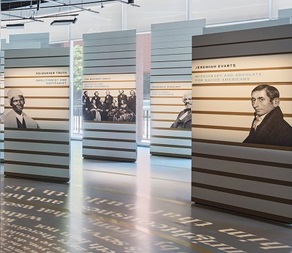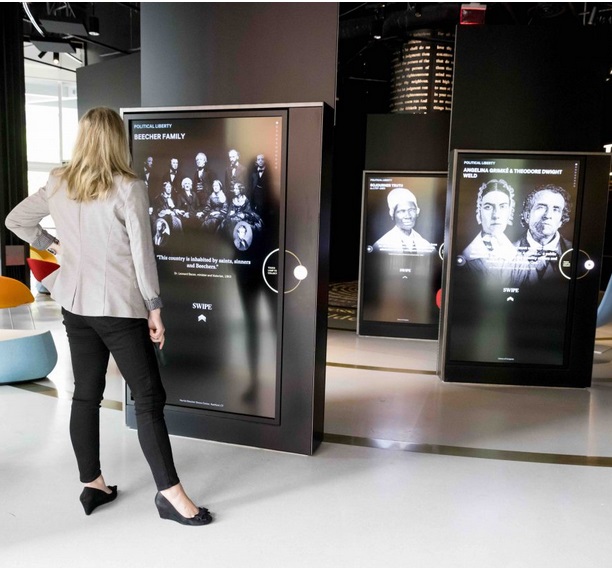
Recreational education depends on the interplay of multiple modalities, as developed into an art-form at the greatest of today’s museums. The amount of information and fun that can be packed into an on-screen game is practically limitless, and does not need a large facility to captivate a visitor. Thus, the new community “museum” or “education hub” doesn’t need to have many such educational ‘games’ to become a valuable community resource. Displays contributing to the goals of an educational activity hub at St. Michael’s will depend on the larger educational objectives, which begin and end with attitude and appetite.
We are looking to use high-tech interactive information-game displays such as were used at the Faith and Liberty Discovery Center (shown below). The full-size high-definition video-walls such as the ones shown here can include films, questionnaires, animations, as well as prompts and controls that support multi-person play. They will include the ability to ‘hook-up’ and establish a wi-fi connection to your phone if you wish to download materials, or receive lists of links to follow-up and follow your curiosity to continue the research game.


Educational Games in a Community Hub
The philosophy behind creating a community ‘educational activities hub’ is to balance the modalities of social vs intellectual cognition. We wish to develop the curiosity and attitude in our community family, creating lifelong learners. Yet in today’s media-dominated world, the draw of technology is very real and must be carefully-weighted in the balance. Technology represents just one complex modality: that of intellectual capacity.
Recreational education will rely as much on the docent/re-enactor/learning counselor as on the high-tech A.I. game-display. Multi-player screens are as much for the docent-visitor guidance and mentoring as for multi-visitor play. The path to wealth through the benefits of knowledge must be carefully-weighted against the balances of emotion and spirit. Displays contributing to the goals of an educational activity hub at St. Michael’s will depend on the larger educational objectives, both beginning and ending with attitude and appetite.
Engineering Investment
The investment cost in developing these interactive educational “game-walls” can be upwards of $120,000, with the hardware running upwards of $20,000 per unit. This is far beyond what any community organization could raise. The table below represents the cost of creating engineering specifications for the greater programming effort and higher-tech displays. As in construction work, the preliminary engineering costs between 8%-10% of the final construction. What is to be produced for the investment shown, will be a web-version of the knowledge base to be used to create a fully-programmed ‘playing field’ for the educational game which could include holography or VR.
Phase One will be used as a test-bed. As can be seen in the table below, the “knowledge field” for each of the proposed educational games are far more important (and engaging to a lifelong learner) than the technology used to engage less knowledgeable visitors. Screen displays that are adequate for any good student to learn from would be replaced for Phase Two, which is aimed at engaging the otherwise disinterested tourist or kid.
As in traditional investment, when a partial prototype of the final product is created and the Phase One web version of the knowledge field is built, we anticipate raising the capital for Phase Two from partnering churches, organizations, or private investors wishing to purchase the Phase Two finished product for their facilities.
